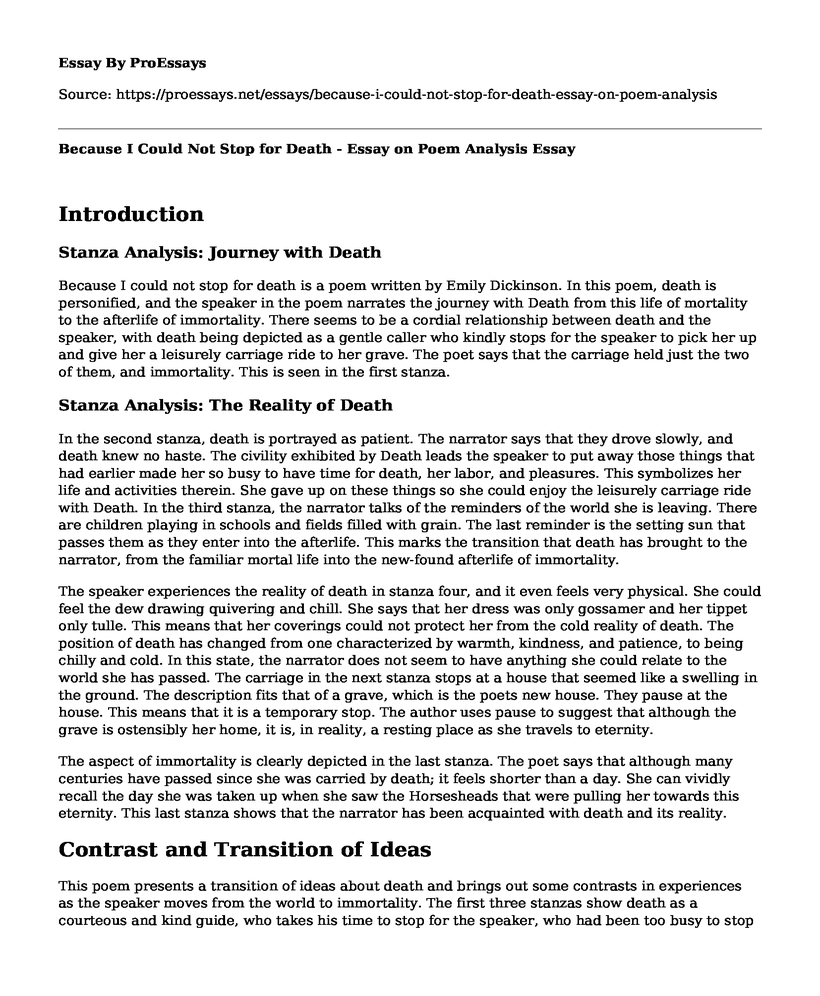Introduction
Stanza Analysis: Journey with Death
Because I could not stop for death is a poem written by Emily Dickinson. In this poem, death is personified, and the speaker in the poem narrates the journey with Death from this life of mortality to the afterlife of immortality. There seems to be a cordial relationship between death and the speaker, with death being depicted as a gentle caller who kindly stops for the speaker to pick her up and give her a leisurely carriage ride to her grave. The poet says that the carriage held just the two of them, and immortality. This is seen in the first stanza.
Stanza Analysis: The Reality of Death
In the second stanza, death is portrayed as patient. The narrator says that they drove slowly, and death knew no haste. The civility exhibited by Death leads the speaker to put away those things that had earlier made her so busy to have time for death, her labor, and pleasures. This symbolizes her life and activities therein. She gave up on these things so she could enjoy the leisurely carriage ride with Death. In the third stanza, the narrator talks of the reminders of the world she is leaving. There are children playing in schools and fields filled with grain. The last reminder is the setting sun that passes them as they enter into the afterlife. This marks the transition that death has brought to the narrator, from the familiar mortal life into the new-found afterlife of immortality.
The speaker experiences the reality of death in stanza four, and it even feels very physical. She could feel the dew drawing quivering and chill. She says that her dress was only gossamer and her tippet only tulle. This means that her coverings could not protect her from the cold reality of death. The position of death has changed from one characterized by warmth, kindness, and patience, to being chilly and cold. In this state, the narrator does not seem to have anything she could relate to the world she has passed. The carriage in the next stanza stops at a house that seemed like a swelling in the ground. The description fits that of a grave, which is the poets new house. They pause at the house. This means that it is a temporary stop. The author uses pause to suggest that although the grave is ostensibly her home, it is, in reality, a resting place as she travels to eternity.
The aspect of immortality is clearly depicted in the last stanza. The poet says that although many centuries have passed since she was carried by death; it feels shorter than a day. She can vividly recall the day she was taken up when she saw the Horsesheads that were pulling her towards this eternity. This last stanza shows that the narrator has been acquainted with death and its reality.
Contrast and Transition of Ideas
This poem presents a transition of ideas about death and brings out some contrasts in experiences as the speaker moves from the world to immortality. The first three stanzas show death as a courteous and kind guide, who takes his time to stop for the speaker, who had been too busy to stop for death. Death kindly picks her up and carries her in his carriage to eternity. The narrator is not frightened by death but rather is awed by his kindness and lack of haste that she puts away her labor and leisure that have been holding her from death. There is the aspect of nostalgia as the narrator together with the carriage passes through schools, fields of grain and the sun passes them. This change immediately after the sun passes them marking the finality of mortal life. The warm feeling is contrasted with the realization of death as cold and sinister. Even her clothing does not provide warmth to the chill. Through this transition, Emily brings out the aspect of contrast in a clear and vivid way.
Theme of Immortality and Eternity
The poem also carries the theme of immortality or eternity. The idea is brought up in the last line of the first stanza when she says that the carriage held just the two of them, (the narrator and Death), and immortality. This idea is portrayed as the underlying goal of this poem, and it ends with the narrator having obtained it in the last paragraph. Time has lost meaning and centuries feel like a day. Time is gone, and the speaker comes to a realization that death was not just death, but immortality. This is seen when she claims that she surmised the horses heads towards eternity. The fact that the poem ends with the word eternity affirms the underlying theme of immortality into the infinite.
This poem has been rated by critics as one of the greatest in the English language. Every image in this poem has been perfectly and beautifully fused with the central idea. Rhyme has been used in stanzas 1, 2, 4 and 6. Figures of speech such as alliteration, paradox, and personification have been used. This passes the poem as a great literary work.
Cite this page
Because I Could Not Stop for Death - Essay on Poem Analysis. (2021, Jun 17). Retrieved from https://proessays.net/essays/because-i-could-not-stop-for-death-essay-on-poem-analysis
If you are the original author of this essay and no longer wish to have it published on the ProEssays website, please click below to request its removal:
- Literature Analysis Essay on "Love's Labor's Lost"
- Essay Example on Goody Two-Shoes: Orphaned in Isolation, Guided by God
- Symbolism in Sir Gawain and the Green Knight Essay
- Essay on I Hear America Singing: Comparing Walt Whitman and Langston Hughes
- Yellow Wallpaper: Literary Devices to Present Ideas & Themes - Essay Sample
- Paper Example on Comparing Motifs in A Haunted House & The Jolly Corner
- Essay Sample on Psychoanalytic Literary Theory







